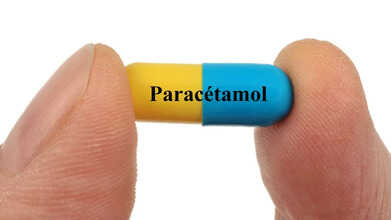- Health Conditions A-Z
- Health & Wellness
- Nutrition
- Fitness
- Health News
- Ayurveda
- Videos
- Medicine A-Z
- Parenting
- Web Stories
Blue Waffle Disease: Is It Real or Fake? Complete Truth About This Internet Hoax and Real STI Symptoms to Watch For

Image Credit: Canva
The "blue waffle disease" stands out as a prime example of how quickly a hoax can gain traction in the world of internet myths and misinformation. Since 2010, the fictional condition has been falsely claimed to be an STI that can cause labia or vagina to turn blue and mimic symptoms of real STIs. The myth is not real, although it is depicted sensationalized. Here's a detailed breakdown of the myth, its origins, and what you should know about real STI risks.
What is the Blue Waffle Disease?
The term "blue waffle" originated online from the perspective of an internet hoax predicated on shock value. Using a slang term for "waffle," referring to the vagina, the hoax itself created and distributed photos of what looked like bruising with a distinct blue undertone to a labia; such images were augmented with descriptions of symptoms manufactured for credibility and alarm value.
Also Read: What Is Leucovorin? The Drug Trump Suggests As A Treatment For Autism?
The pranksters first teased the online surfers by asking them to find "blue waffle disease," and then shocked them with such images. But medical professionals were quick to dismiss the claims. It soon became apparent that the pictures were either doctored using digital editing or had been altered with the help of substances like gentian violet, a blue antiseptic used in the treatment of vaginal infections.
The myth lived on despite wide dissemination of its falsity. Public figures were not exempt; for instance, in 2013, a New Jersey council member presented a proposal for legislative actions against the disease, which was non-existent. It showed the influence of false information and the imperative of having correct sexual health information.
Busting the Myth
Blue waffle disease is not a real medical condition or STI. No credible health websites, peer-reviewed journals, or medical literature have it listed. It may have been a mere exaggeration of real STI symptoms, but no such infection causes the vagina and labia to turn blue as in the hoax.
The spread of this blue waffle myth underscores how important it is to sort fact from fiction when it comes to health information. Misleading information like this can create avoidable fear and draw one's attention away from actual risks of STIs.
Real STI Symptoms vs. Blue Waffle Claims
Blue waffle disease isn't real, but the symptoms some people claim come with this disease do correspond to the symptoms of actual infections or sexually transmitted infections. For example:
Chlamydia and Gonorrhea: Bacterial infections can cause abnormal discharge, pelvic pain, and discomfort.
Trichomoniasis: A parasitic STI that causes itching, irritation, and unusual vaginal discharge.
Genital Herpes: This infection caused by the herpes simplex virus can cause painful sores and scabs around the genital area.
Vaginal Yeast Infections: These can cause redness, swelling, and irritation, but not blue discoloration.
If there are any symptoms such as bumps, sores, itching, or discharge, it's important to consult a healthcare provider for proper diagnosis and treatment.
Can Anything Turn the Vagina Blue?
The concept of a blue-colored vagina as a medical condition is quite far-fetched. However, there is one rare gynecological condition called cervical endometriosis that may cause bluish lesions. This happens when the uterine lining tissue grows outside the uterus and extends to the cervix, causing discoloration, pain, and abnormal discharge. Importantly, cervical endometriosis is not sexually transmitted, and it does not affect the labia in the way described in the blue waffle hoax.
Importance of STI Screenings
Even though blue waffle disease does not exist, the reality is that STI screenings are very important. According to the Centers for Disease Control and Prevention, these are general guidelines on STI testing:
1. All individuals aged 13-64 should be tested for HIV at least once during their lifetime, with yearly testing for persons at increased risk.
2. Sexually active women under 25 and older women with risk factors, such as new or multiple partners, should be tested annually for gonorrhea and chlamydia.
3. Pregnant women should be tested for syphilis, hepatitis B, and HIV early in pregnancy to assure both maternal and fetal health.
4. Sexually active men should be tested annually for HIV, syphilis, chlamydia, and gonorrhea to be sexually healthy.
5. The individuals who share needles should test themselves annually for HIV to minimize the risks from the sharing of needles.
Regular testing will help in diagnosing infections early, so the treatment will be more effective and the risk of complications will be minimized.
STI Prevention
Preventive measures can greatly reduce the chances of getting an STI. Here are some strategies recommended by the CDC:
- Vaccination: Protect yourself against HPV and hepatitis B with vaccines.
- Safe Sex Practices: Use external condoms consistently and correctly.
- Limit Sexual Partners: Reducing the number of sexual partners lowers exposure risk.
- Monogamy: Being monogamous with a tried partner will add another protective layer.
Education and awareness form the best antidote for myths such as blue waffle disease and public health education in the prevention and risks of STIs.
Blue waffle disease is a fabricated condition with no basis in medical science. The hoax highlights how misinformation can spread and create unnecessary panic. However, it also serves as a reminder of the importance of educating people about real STI risks, symptoms, and prevention.
If you notice any unusual symptoms in your genital area, do not hesitate to seek professional advice from a healthcare provider. Proper diagnosis and treatment may help maintain sexual health as well as general well-being.
Paracetamol Should Not Be Mixed With These Medications, Doctors Advise

Credits: Canva
The NHS has issued a warning for anyone using a common painkiller, highlighting possible harmful interactions with other medications. Across the UK, many people turn to over-the-counter medicines for daily aches, colds, and minor illnesses. Among these, paracetamol is one of the most widely used, often taken for headaches, back pain, and cold symptoms. But, like any medication, it carries certain risks.
Who Should Be Careful?
The NHS has provided guidance on using paracetamol safely, including which drug combinations should be avoided. “Paracetamol is not suitable for some people,” the health body explains. This includes individuals who take warfarin, a drug that prevents blood clots. If you are on warfarin, you should check with your GP before taking paracetamol, the NHS advises. “Paracetamol can raise the risk of bleeding in those who regularly take warfarin.”
Safe Dosing Guidelines
Small doses of paracetamol alongside warfarin are generally considered safe. The NHS adds: “It’s safe to take paracetamol if you’re on warfarin. Stick to the lowest dose that relieves your pain. Exceeding four 500mg tablets in 24 hours for more than a few days can slow your blood clotting, putting you at risk of bleeding.”
Avoid Double Dosing
Combining paracetamol with other medicines containing the same ingredient—like co-codamol or some cold and flu remedies—can be risky due to the danger of overdose. Other common painkillers, such as ibuprofen, aspirin, or codeine, do not contain paracetamol and can safely be taken at the same time.
Check with Your Doctor
The NHS advises consulting a doctor before taking paracetamol if you’re on medications for epilepsy or tuberculosis (TB), as these combinations can also pose risks.
Herbal Remedies and Supplements
Generally, paracetamol is not affected by herbal supplements, though the NHS notes: “There isn’t enough information to say whether herbal remedies, complementary medicines, or supplements are safe with paracetamol. They are not tested the same way as prescription or pharmacy medications and may interact differently.” Patients should inform their doctor or pharmacist about any other medicines or supplements they are taking.
Side Effects of Paracetamol
When taken at the recommended dose, paracetamol “very rarely” causes side effects. For a full list, refer to the information leaflet inside the packaging.
Serious Allergic Reactions
In rare cases, a serious allergic reaction (anaphylaxis) can occur. The NHS advises calling 999 immediately if you notice:
- Swelling of lips, mouth, throat, or tongue
- Rapid or labored breathing, wheezing, or a choking sensation
- A tight throat or difficulty swallowing
- Skin, lips, or tongue turning blue, grey, or pale (on darker skin, check palms or soles)
- Sudden confusion, extreme drowsiness, or dizziness
- Fainting and unresponsiveness
- A child appearing limp, floppy, or unresponsive, with difficulty lifting or focusing their head
Do You Zone Out Often? Study Finds This May Be A Way For Your Brain Do 'Maintenance'

(Credit-Canva)
That sudden, foggy feeling where you can't focus, especially when you're super tired? New research suggests that these moments of zoning out are actually your brain's last-ditch effort to do the important cleaning it normally saves for when you're fast asleep. Your brain is trying to take a quick, emergency break.
We have all had days when focusing seems too difficult and you keep ‘spacing out’. When this happens, you take a moment to regain your composure and get back to what you were doing. While you may think that it is a simple lapse in attention, there is a lot that happens in your brain during this time.
The research, published in the Nature Neuroscience, shows this is the time your brain does its ‘maintenance work’ to ensure maximum functionality.
Why Do We Zone Out?
Scientists at MIT used special scanners to look deep inside the brain while people were trying to concentrate. They discovered that the exact moment someone zoned out, a wave of cerebrospinal fluid (CSF), a clear fluid that surrounds the brain, whooshed out, and then flowed right back in. This movement of fluid looks exactly like the process that happens during deep sleep, when the fluid washes away built-up waste and toxins from the day. When you're awake and tired, your brain is trying to force this cleaning process to happen.
How Does Our Brain Keep Functioning Fluidly?
A leading neuroscientist from the study explained that if you skip sleep, these cleaning waves start happening while you're awake, even though they shouldn't. The problem is that while the fluid is flowing and cleaning, you lose your ability to pay attention. It's a trade-off: your brain tries to clean up, but the price is that you can't focus on what you're doing. It’s almost like your brain is desperately trying to squeeze in a tiny bit of "microsleep" maintenance, which steals your focus.
The researchers had people do tests in the lab twice: once after they were well-rested, and once after they stayed up all night. Unsurprisingly, people performed much worse when they hadn't slept. Critically, the zoning out happened far more often after the all-nighter. When they looked at the brain data, they saw a clear pattern: when people's reaction times slowed down (meaning they were zoning out), the big fluid cleaning waves were always present. This strongly suggests your tired brain is trying to use these quick cycles to restore function, even if it makes you temporarily lose focus.
How Do We Know When We Zone Out?
The research revealed that when people zoned out, not only did the brain fluid move, but other things changed, too. Their breathing and heart rate slowed down, and their pupils got smaller. This makes the scientists suspect that a single, powerful "master switch" in the body controls both your high-level functions (like attention and perception) and these automatic, basic physical processes (like fluid movement and heart rate). The finding suggests that a lack of sleep affects your whole body through one central system.
Your Daily Work 'Grind' Is Ruining Your Heart Health, Cardiologist Explains How These Daily Habits Affect Your Heart

(Credit-Canva)
Recently, we are seeing a rise in ‘grind culture’. People are encouraged to pack their days with work and be as productive as possible to secure future success. However, did you know that chasing this success could come at the cost of your heart's health? Dr. Dmitry Yaranov, MD, a cardiologist, who often shared important health advice and knowledge on Instagram videos, explained posted about how as a practicing healthcare professional, there are many heart facts that he wished his patients knew about.
Things we often perceive as important for our careers can come at the cost of our mental and physical health. By not realizing the value of their health and ignoring their limits, people often stretch themselves too far, which can result in reaching a breaking point.
In a recent video posted with the text, “After treating thousands of patients with heart failure this are the things I wish more people knew before it was too late” in the caption he listed 6 hard facts that most people ignore.
6 Habits That Are Leading You To Heart Failure
In the caption Dr. Yaranov explained that cardiovascular health involves much more than just hitting the gym and eating salads. Your heart health is fundamentally tied to sleep, stress management, environmental factors, access to resources, and even the state of your gut. Fix the foundation, not just the numbers.
Sleep Deprivation is Dangerous
Sleeping only six hours nightly and pushing yourself is a serious threat, not a badge of honor. This chronic sleep loss significantly raises your long-term risk of developing severe conditions like heart failure, having a stroke, or experiencing sudden cardiac death. Your body needs rest to recover.
Air Quality Hardens Arteries
Commuting daily in heavy traffic means breathing exhaust and particulate matter. This consistent exposure to air pollution does more than irritate your lungs; scientific studies confirm it literally hardens your arteries, increasing your risk for major cardiac events over time.
Stress Causes Overload
If you are always stressed and simply "pushing through" without managing the pressure, your body is producing too much cortisol. This hormonal overload leads to persistent high blood pressure and widespread inflammation, key factors that severely damage the cardiovascular system.
Gum Health Impacts Heart Health
Ignoring routine dental care and having gum disease creates chronic infection in your mouth. This persistent gum disease results in more body-wide inflammation, which is directly linked to a significantly higher risk of heart attack and other cardiovascular problems.
Food Access Matters
Even if you have the best intentions to eat well, living where healthy food is hard to find (a food desert) makes it difficult. This lack of access to nutritious options leads to worse cardiac outcomes, proving that environment, not just personal willpower, shapes your health.
Gut Health Affects Vital Signs
The state of your digestive system should not be ignored. The millions of bacteria in your gut microbiome play a critical, unrecognized role in helping your body regulate blood pressure and cholesterol levels. You must consciously feed your gut bacteria the right way.
© 2024 Bennett, Coleman & Company Limited

